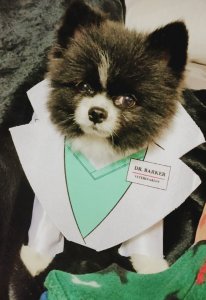
Along with antibiotics and vaccinations, advancements in dental care and oral hygiene have contributes greatly to the overall health of people and the populations as a whole. Most of us are trained to brush daily, floss, use mouthwash, and visit the dentist for periodic cleanings. Just like in people, pets’ teeth also need routine care and periodic cleaning to prevent the pain and potential disease of loose or infected teeth.
What are the signs of dental disease in pets?
Bad breath is probably the first thing people notice in pets with bad teeth. Some pets may exhibit pain or difficulty upon eating or chewing. If the pets’ mouth is examined, brown tartar on the teeth or red gums can be seen. With severe disease, receding gums, loose teeth and pus can be present. Some pets, especially small dogs, may have baby teeth that never fell out. These “extra teeth” or “double teeth” cause crowding in the mouth and need to be removed.
I’ve never worried about an animal’s teeth before. How important is dental care in pets?
It is true that a lot has changed in veterinary medicine and the way we care for pets. Also pets today live longer than they used to. Dental problems such as loose or infected teeth at the very least cause discomfort and pain that we can alleviate. No one would want to live with a toothache. More importantly, severe dental disease can cause bacteria to enter the blood stream, thereby infecting the kidneys, liver or heart, causing more serious diseases. A badly infected mouth and gum-line can be as bad for your pet’s long term health as a chronically infected skin wound. No one would ignore a chronically infected ear or skin wound, yet many of us ignore out pet’s chronically infected mouths.
What can I do to keep my pet’s mouth healthy?
There are a number of ways to care for your pet’s teeth and gums. It is best to start when your pet is young and easier to train. These recommendations apply regardless of age and are especially important after professional cleaning.
Brushing:
Brushing is the BEST way to clean your pet’s teeth. To be effective, brushing should be done at least three times a week. Pets should not use human toothpaste, as it 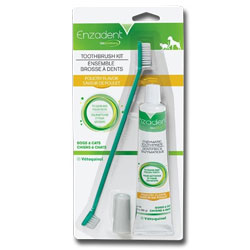 is bad to swallow too much human toothpaste (as with small children). Dogs and cats use special enzymatic tooth paste that is flavored (usually poultry) and is safe to be swallowed. Whereas human tooth paste is more of a pumice or polish, animal tooth paste works to break down tartar and kill bacteria with enzymatic action. Therefore, the animal toothpaste really only needs to be applied to the teeth and vigorous brushing should not be necessary. It takes some amount of training to get your pet used to having its teeth brushed. We recommend that you start slow, spending the first week getting your pet used to you lifting the lips and touching the teeth. In the second week, introduce the tooth brush, and finally, the paste. Once you and your pet get used to it, brushing may only take 30 seconds, three times a week. This is a chore children can easily do, if they have a good relationship with the pet.
is bad to swallow too much human toothpaste (as with small children). Dogs and cats use special enzymatic tooth paste that is flavored (usually poultry) and is safe to be swallowed. Whereas human tooth paste is more of a pumice or polish, animal tooth paste works to break down tartar and kill bacteria with enzymatic action. Therefore, the animal toothpaste really only needs to be applied to the teeth and vigorous brushing should not be necessary. It takes some amount of training to get your pet used to having its teeth brushed. We recommend that you start slow, spending the first week getting your pet used to you lifting the lips and touching the teeth. In the second week, introduce the tooth brush, and finally, the paste. Once you and your pet get used to it, brushing may only take 30 seconds, three times a week. This is a chore children can easily do, if they have a good relationship with the pet.
Oral Gel: After brushing, the use of oral gel is the next best way to reduce tartar. 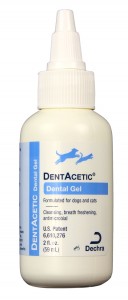 Since tartar is largely composed of bacteria, special anti-bacterial gels or additives to drinking-water are beneficial. Although these gels may be easier to administer to your pet, they are not as effective as brushing.
Since tartar is largely composed of bacteria, special anti-bacterial gels or additives to drinking-water are beneficial. Although these gels may be easier to administer to your pet, they are not as effective as brushing.
Special Treats and Foods: Some pet-care companies have come up with certain treats that help reduce tartar build-up. Treats and raw hides are available that have been impregnated with animal toothpaste. By chewing these treats your pet can get a mouthful of toothpaste without having to brush. Additionally, special foods and treats are made so pets must bite into the kibble to eat it. Having the teeth sink down into the food cleans the surface of the tooth with every bit. Such foods and treats are easiest to administer but are not as effective as brushing or rinsing.
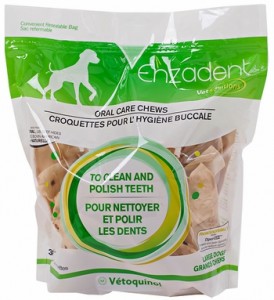
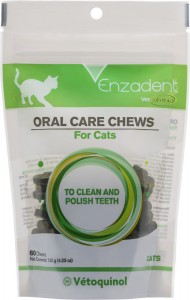
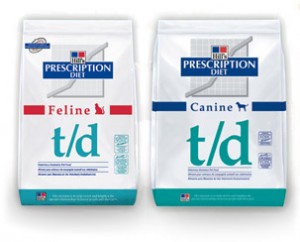
Sealers: Once a dental cleaning has been performed on a pet, plaque and tartar begin reforming on the surface of the teeth at a predictable rate. Sealers are products designed to be applied periodically to the front surfaces of all teeth. Tartar and plaque are formed by bacteria that cling to the tooth surface. Sealers reduce plaque and tartar formation by making it more difficult for these bacteria to adhere to the teeth. We recommend Oravet Plaque Prevention Gel, which we apply immediately after a dental cleaning is performed. The product should be reapplied once a week at home by the owner. The research has shown that regular application of Oravet Gel can significantly reduce tartar and plaque formation.
Daily brushing + regular dental checkups + the right nutrition = improved oral and overall health of pets.
It should be said that these measures help slow the accumulation of tartar but will not completely stop it. Your pet may need a professional cleaning at some point even with the most stringent home care. Think about all you do to keep your own teeth healthy at home, yet you still need periodic cleanings by a dentist.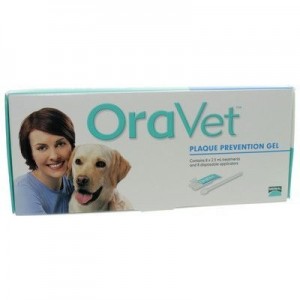
My pet’s teeth need professional cleaning. What is involved in a dental cleaning?
Animal’s teeth are cleaned in the same way a person’s teeth are cleaned, except that pets need to anesthetize. We use an ultrasonic scalar, polisher and paste and finish with fluoride foam. Loose, infected or broken teeth that cause problems or pain need to be removed. Although root canals, caps and, crowns can be done for pets, these procedures require a veterinary dental specialist, usually only available at veterinary schools or in major metropolitan areas. Many people cringe at the notion of having a pet’s unhealthy teeth removed. If the dental disease is severe, pets may receive antibiotics or pain relievers before, during and after the procedure.
How involved will my pet’s dental cleaning be?
We can often get an idea of the severity of an animal’s dental disease by examining the mouth. However, pets that are especially sore or prone to biting will not allow a complete examination. Some teeth problems have to be diagnosed by probing the gum line with fine instruments. For these reasons, it might be impossible to tell exactly how severe the dental disease is, or how many teeth need to be pulled prior to the procedure. It’s like when a mechanic or plumber tells you he’ll have to get started on a problem before he can tell how truly involved it is. These factors also make very precise price quotes impractical although we can usually give an accurate estimated price range.
I think my pet may need a cleaning but I’m worried about putting her under anesthesia. Is it safe?
It’s true that dental problems develop with age, and sometimes older pets are recommended for dental cleaning. There is always a small risk associated with anesthesia. However with modern drugs and monitoring equipment, problems with anesthesia are quite rare. We can also perform blood test to determine the health of your pet’s liver and kidneys, a s these are the organs that metabolize the anesthetic drugs. Don’t forget that dental disease is a detriment to your pet’s health and the risk of not dealing with the dental disease may be greater than the risk or anesthesia. Please understand that a problem during anesthesia is the last thing we at the clinic want to have happen too. We will check your pet and if we feel the anesthesia is overly dangerous, we will make other recommendations.
My pet can’t have its teeth cleaned and he won’t let me brush appropriately. What choices do I have?
If it is impossible to clean the teeth as they should be, there are strategies we can use to keep problems associated with the dental infection to a minimum. “Pulse therapy” involves giving a pet a short course or antibiotics every month. This monthly “pulse” of antibiotics helps to control infection on the gum line and thereby control the potential spread of infection to your pet’s heart, liver and kidneys. We typically give these pets an antibiotic twice a day for the first three days of every month.
